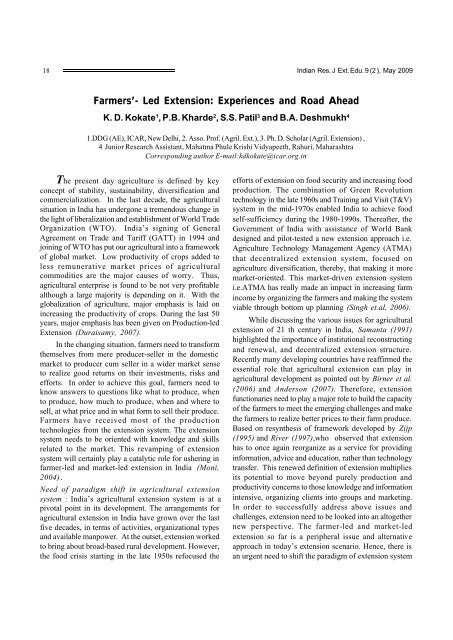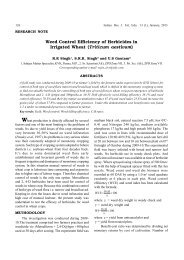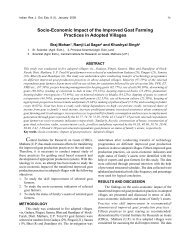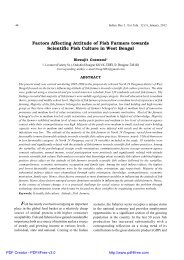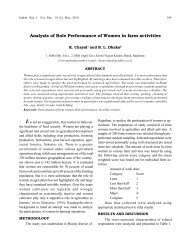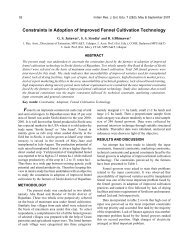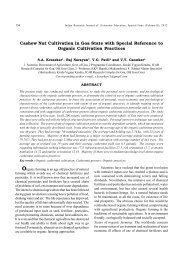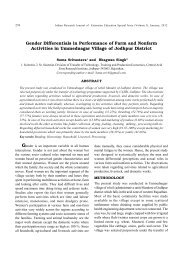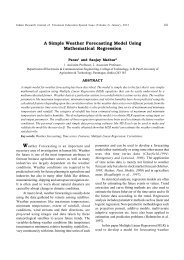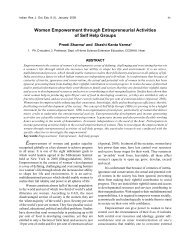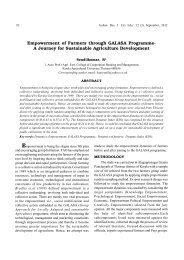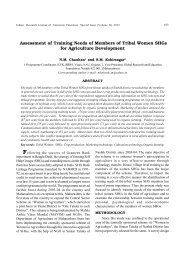Farmers'- Led Extension: Experiences and Road Ahead - Seea.org.in
Farmers'- Led Extension: Experiences and Road Ahead - Seea.org.in
Farmers'- Led Extension: Experiences and Road Ahead - Seea.org.in
Create successful ePaper yourself
Turn your PDF publications into a flip-book with our unique Google optimized e-Paper software.
18 Indian Res. J Ext. Edu. 9 (2 ), May 2009<br />
Farmers’- <strong>Led</strong> <strong>Extension</strong>: <strong>Experiences</strong> <strong>and</strong> <strong>Road</strong> <strong>Ahead</strong><br />
K. D. Kokate 1 , P.B. Kharde 2 , S.S. Patil 3 <strong>and</strong> B.A. Deshmukh 4<br />
1.DDG (AE), ICAR, New Delhi, 2. Asso. Prof. (Agril. Ext.), 3. Ph. D. Scholar (Agril. <strong>Extension</strong>) ,<br />
4 Junior Research Assistant, Mahatma Phule Krishi Vidyapeeth, Rahuri, Maharashtra<br />
Correspond<strong>in</strong>g author E-mail:kdkokate@icar.<strong>org</strong>.<strong>in</strong><br />
The present day agriculture is def<strong>in</strong>ed by key<br />
concept of stability, susta<strong>in</strong>ability, diversification <strong>and</strong><br />
commercialization. In the last decade, the agricultural<br />
situation <strong>in</strong> India has undergone a tremendous change <strong>in</strong><br />
the light of liberalization <strong>and</strong> establishment of World Trade<br />
Organization (WTO). India’s sign<strong>in</strong>g of General<br />
Agreement on Trade <strong>and</strong> Tariff (GATT) <strong>in</strong> 1994 <strong>and</strong><br />
jo<strong>in</strong><strong>in</strong>g of WTO has put our agricultural <strong>in</strong>to a framework<br />
of global market. Low productivity of crops added to<br />
less remunerative market prices of agricultural<br />
commodities are the major causes of worry. Thus,<br />
agricultural enterprise is found to be not very profitable<br />
although a large majority is depend<strong>in</strong>g on it. With the<br />
globalization of agriculture, major emphasis is laid on<br />
<strong>in</strong>creas<strong>in</strong>g the productivity of crops. Dur<strong>in</strong>g the last 50<br />
years, major emphasis has been given on Production-led<br />
<strong>Extension</strong> (Duraisamy, 2007).<br />
In the chang<strong>in</strong>g situation, farmers need to transform<br />
themselves from mere producer-seller <strong>in</strong> the domestic<br />
market to producer cum seller <strong>in</strong> a wider market sense<br />
to realize good returns on their <strong>in</strong>vestments, risks <strong>and</strong><br />
efforts. In order to achieve this goal, farmers need to<br />
know answers to questions like what to produce, when<br />
to produce, how much to produce, when <strong>and</strong> where to<br />
sell, at what price <strong>and</strong> <strong>in</strong> what form to sell their produce.<br />
Farmers have received most of the production<br />
technologies from the extension system. The extension<br />
system needs to be oriented with knowledge <strong>and</strong> skills<br />
related to the market. This revamp<strong>in</strong>g of extension<br />
system will certa<strong>in</strong>ly play a catalytic role for usher<strong>in</strong>g <strong>in</strong><br />
farmer-led <strong>and</strong> market-led extension <strong>in</strong> India (Moni,<br />
2004).<br />
Need of paradigm shift <strong>in</strong> agricultural extension<br />
system : India’s agricultural extension system is at a<br />
pivotal po<strong>in</strong>t <strong>in</strong> its development. The arrangements for<br />
agricultural extension <strong>in</strong> India have grown over the last<br />
five decades, <strong>in</strong> terms of activities, <strong>org</strong>anizational types<br />
<strong>and</strong> available manpower. At the outset, extension worked<br />
to br<strong>in</strong>g about broad-based rural development. However,<br />
the food crisis start<strong>in</strong>g <strong>in</strong> the late 1950s refocused the<br />
efforts of extension on food security <strong>and</strong> <strong>in</strong>creas<strong>in</strong>g food<br />
production. The comb<strong>in</strong>ation of Green Revolution<br />
technology <strong>in</strong> the late 1960s <strong>and</strong> Tra<strong>in</strong><strong>in</strong>g <strong>and</strong> Visit (T&V)<br />
system <strong>in</strong> the mid-1970s enabled India to achieve food<br />
self-sufficiency dur<strong>in</strong>g the 1980-1990s. Thereafter, the<br />
Government of India with assistance of World Bank<br />
designed <strong>and</strong> pilot-tested a new extension approach i.e.<br />
Agriculture Technology Management Agency (ATMA)<br />
that decentralized extension system, focused on<br />
agriculture diversification, thereby, that mak<strong>in</strong>g it more<br />
market-oriented. This market-driven extension system<br />
i.e.ATMA has really made an impact <strong>in</strong> <strong>in</strong>creas<strong>in</strong>g farm<br />
<strong>in</strong>come by <strong>org</strong>aniz<strong>in</strong>g the farmers <strong>and</strong> mak<strong>in</strong>g the system<br />
viable through bottom up plann<strong>in</strong>g (S<strong>in</strong>gh et.al, 2006).<br />
While discuss<strong>in</strong>g the various issues for agricultural<br />
extension of 21 th century <strong>in</strong> India, Samanta (1991)<br />
highlighted the importance of <strong>in</strong>stitutional reconstruct<strong>in</strong>g<br />
<strong>and</strong> renewal, <strong>and</strong> decentralized extension structure.<br />
Recently many develop<strong>in</strong>g countries have reaffirmed the<br />
essential role that agricultural extension can play <strong>in</strong><br />
agricultural development as po<strong>in</strong>ted out by Birner et al.<br />
(2006) <strong>and</strong> Anderson (2007). Therefore, extension<br />
functionaries need to play a major role to build the capacity<br />
of the farmers to meet the emerg<strong>in</strong>g challenges <strong>and</strong> make<br />
the farmers to realize better prices to their farm produce.<br />
Based on resynthesis of framework developed by Zijp<br />
(1995) <strong>and</strong> River (1997),who observed that extension<br />
has to once aga<strong>in</strong> re<strong>org</strong>anize as a service for provid<strong>in</strong>g<br />
<strong>in</strong>formation, advice <strong>and</strong> education, rather than technology<br />
transfer. This renewed def<strong>in</strong>ition of extension multiplies<br />
its potential to move beyond purely production <strong>and</strong><br />
productivity concerns to those knowledge <strong>and</strong> <strong>in</strong>formation<br />
<strong>in</strong>tensive, <strong>org</strong>aniz<strong>in</strong>g clients <strong>in</strong>to groups <strong>and</strong> market<strong>in</strong>g.<br />
In order to successfully address above issues <strong>and</strong><br />
challenges, extension need to be looked <strong>in</strong>to an altogether<br />
new perspective. The farmer-led <strong>and</strong> market-led<br />
extension so far is a peripheral issue <strong>and</strong> alternative<br />
approach <strong>in</strong> today’s extension scenario. Hence, there is<br />
an urgent need to shift the paradigm of extension system
Indian Res. J Ext. Edu. 9 (2 ), May 2009 19<br />
from mere production-led to farmer-led <strong>and</strong> market-led<br />
extension system on end-to-end basis. Therefore, new<br />
framework for conceptualiz<strong>in</strong>g <strong>and</strong> operat<strong>in</strong>g extension<br />
system is evolved <strong>and</strong> diagrammatically presented <strong>in</strong> Table<br />
1 <strong>and</strong> its practical approach has been discussed with<br />
relevant experiences.<br />
Table 1. Paradigm shift from production-led to farmers-led extension system<br />
Components Production-led Farmers-led<br />
Purpose/ Transfer of production Capacity build<strong>in</strong>g (especially farmers extensionist), create para-professional<br />
Objective technologies extension workers, creat<strong>in</strong>g or strengthen<strong>in</strong>g local <strong>in</strong>stitutions<br />
Goal Food self-sufficiency Livelihood security <strong>in</strong>clud<strong>in</strong>g food, nutrition, employment to alleviate poverty,<br />
susta<strong>in</strong>ability <strong>and</strong> conserv<strong>in</strong>g bio-diversity<br />
Approach Top-down, commodity <strong>and</strong> Participatory, bottom-up <strong>and</strong> dem<strong>and</strong> driven<br />
supply driven<br />
Actors Mostly public <strong>in</strong>stitutions Pluralistic with public, private, non-government <strong>and</strong> farmers <strong>org</strong>anizations as a<br />
partner rather than competitors<br />
Mode Mostly <strong>in</strong>terpersonal/ Integration of clients oriented on-farm participatory/experiential learn<strong>in</strong>g<br />
<strong>in</strong>dividual approach methods supported by ICTs <strong>and</strong> media<br />
Role of extension Limited to delivery mode <strong>and</strong> Facilitation of learn<strong>in</strong>g, build<strong>in</strong>g overall capacity of farmers <strong>and</strong> encourag<strong>in</strong>g<br />
agents feedback to research system farmers experimentation<br />
L<strong>in</strong>kages/liaison Research-<strong>Extension</strong>-Farmers Research- <strong>Extension</strong>-Farmers Organizations( FIGs, CIGs, SHGs)<br />
Emphasis Information management, Knowledge management <strong>and</strong> shar<strong>in</strong>g<br />
Production “Seed to Seed”<br />
Nature of Input <strong>in</strong>tensive, crop based Knowledge <strong>in</strong>tensive, broad based, farm<strong>in</strong>g system perspective <strong>and</strong> blend<strong>in</strong>g<br />
technology <strong>and</strong> general recommendations with ITKs.<br />
as per agro-climatic zone,<br />
fixed package of <strong>in</strong>formation<br />
Critical areas Improvement, production Decision support system, <strong>in</strong>tegrated farm<strong>in</strong>g system approach, natural resource<br />
<strong>and</strong> protection<br />
management, clients group formation <strong>and</strong> community empowerment<br />
Critical <strong>in</strong>puts Money <strong>and</strong> material Access to Information, build<strong>in</strong>g human <strong>and</strong> social capital<br />
Accountability Mostly government To farmers rather than donors<br />
MPKV experiences of farmers’-led extension approach<br />
: The Mahatma Phule Krishi Vidyapeepth<br />
(MPKV), Rahuri has been implement<strong>in</strong>g the novel<br />
concept of Farmers-Scientists Forum (FSF) s<strong>in</strong>ce<br />
October, 2005. The Vice-Chancellor is president, while,<br />
the Director of <strong>Extension</strong> Education is Executive President<br />
of this FSF. The FSF established at Central Campus,<br />
comprises 40 Farmer-Scientist Clubs (FSCs) of 1500<br />
member farmers <strong>in</strong> the jurisdiction of ten districts of the<br />
university. Each FSC has coord<strong>in</strong>ator <strong>and</strong> these FSCs<br />
are attached to the Colleges, Agril. Research Stations<br />
<strong>and</strong> Agricultural Technology Schools. These FSCs<br />
function as Commodity Interest Groups (CIGs). The basic<br />
idea of formulat<strong>in</strong>g the FSCs is to demonstrate <strong>and</strong> to<br />
educate the farmers about the technologies generated<br />
by university at different locations. MPKV has developed<br />
the farms of these members as a model for the village<br />
<strong>and</strong> these farmers <strong>in</strong> turn are servic<strong>in</strong>g as farm leaders<br />
to dissem<strong>in</strong>ate the university technologies to other farmers<br />
<strong>in</strong> their area. Participatory research- extension approach<br />
is be<strong>in</strong>g promoted through the FSF. Regular Monthly<br />
Meet<strong>in</strong>gs <strong>and</strong> Review Meet<strong>in</strong>gs are <strong>org</strong>anized, where<strong>in</strong><br />
there is <strong>in</strong>teraction between FSC members <strong>and</strong> university<br />
scientists. Database of soil, water, cropp<strong>in</strong>g pattern,<br />
various enterprises of member farmers etc.has been<br />
developed by the university <strong>and</strong> accord<strong>in</strong>gly location<br />
specific <strong>in</strong>terventions are suggested for <strong>in</strong>creas<strong>in</strong>g their<br />
<strong>in</strong>come through agro-based enterprises. Some of the<br />
experiences of members of FSF are depicted below:<br />
* Seed Village Programme are regularly implemented<br />
on <strong>org</strong>anized farms of members of FSCs. MPKV<br />
implemented such programme <strong>in</strong> Varur village, Dist.<br />
Ahmednagar on gram (Variety: Virat) on 70 acres<br />
<strong>in</strong> the year 2006-07. The village produced 430<br />
qu<strong>in</strong>tals of Virat seed worth Rs. 21.50 lakhs, which<br />
really boosted the socio-economic condition of the<br />
farmers.<br />
* Another seed programme <strong>in</strong> Tambhere village of<br />
Ahmednagar district <strong>in</strong> 2007-08 yielded 12 farmers<br />
an amount of Rs 2.48 lakhs through sale of 82.8<br />
qu<strong>in</strong>tals certified seed of gram variety Digvijay.
20 Indian Res. J Ext. Edu. 9 (2 ), May 2009<br />
* Demonstrations on yield target<strong>in</strong>g approach (250<br />
tonnes/ha) of Co-265 variety of sugarcane released<br />
by MPKV was carried out on the farms of members<br />
of FSCs <strong>in</strong> Pune <strong>and</strong> Ahmednagar district <strong>in</strong> 2007-<br />
08. These farmers realized average yield of 215<br />
tonnes/ha.This sugarcane variety is now ga<strong>in</strong><strong>in</strong>g<br />
prom<strong>in</strong>ence <strong>in</strong> the sugarcane tract of Maharashtra<br />
through successful FLDs.<br />
* Capacity build<strong>in</strong>g of 800 members of FSCs has been<br />
carried <strong>in</strong> 2008-09 through the programme on Scal<strong>in</strong>g<br />
up of water productivity of <strong>in</strong>creas<strong>in</strong>g livelihood<br />
through teach<strong>in</strong>g cum demonstration to the farmers<br />
<strong>and</strong> tra<strong>in</strong>ers, a project sponsored by M<strong>in</strong>istry of<br />
Agriculture, Govt. of India, New Delhi.<br />
* Demonstrations through Farmers Participatory<br />
Action Research Project sponsored by M<strong>in</strong>istry of<br />
Water Resources, New Delhi are be<strong>in</strong>g implemented<br />
on micro-irrigation systems on farms of 100 member<br />
farmers of FSCs <strong>in</strong> the university jurisdiction s<strong>in</strong>ce<br />
2008-09.<br />
* Good example of farmers’-led <strong>and</strong> market-led<br />
extension has been created through formation of<br />
FSCs. A woman member farmer of FSC Mrs. Vanita<br />
Gunjal from K<strong>and</strong>ali village of Pune district produces<br />
cont<strong>in</strong>ental vegetables for market<strong>in</strong>g <strong>in</strong> five-star<br />
hotels <strong>in</strong> metropolitan cities like Pune <strong>and</strong> Mumbai.<br />
She owns meagre l<strong>and</strong> of 1.87 ha., but the satellite<br />
market<strong>in</strong>g under the guidance of university scientists<br />
have reaped her rich benefits. Market<strong>in</strong>g of these<br />
exotic vegetables is done under the trade name of<br />
Green Pallavi Farms <strong>and</strong> Sales. Mrs. Gunjal is the<br />
w<strong>in</strong>ner of N.G.Ranga Farmer Award for Diversified<br />
Agriculture (2005-06) of the ICAR, New Delhi.<br />
* Another member farmer of FSC Shri. Hanumant<br />
Gajare from Aran village of Solapur district has put<br />
forth an ideal example of farmers’-led / market-led<br />
agriculture through bumper pomegranate production<br />
<strong>in</strong> scarcity area. He has cultivated Phule Bhagawa<br />
pomegranate for export purpose on 1.20 ha. area.<br />
This farmer realized a total <strong>in</strong>come of Rs. 37.20 lakh<br />
through pomegranate export to European countries<br />
<strong>in</strong> 2008-09 season, whereas, he <strong>in</strong>curred an<br />
expenditure of Rs 3.0 lakh. Apart from these<br />
examples, the <strong>in</strong>novative approach of Farmer-Scientist<br />
Forum has led to Farmer to Farmer extension <strong>in</strong> FSF<br />
has helped <strong>in</strong> reduction <strong>in</strong> cost of cultivation <strong>and</strong><br />
<strong>in</strong>creased monetary returns through value addition<br />
<strong>and</strong> market<strong>in</strong>g. These member farmers of FSCs have<br />
achieved outst<strong>and</strong><strong>in</strong>g awards at national <strong>and</strong> state<br />
level.All these f<strong>in</strong>d<strong>in</strong>gs are <strong>in</strong> l<strong>in</strong>e with those of Wakle<br />
et al (1998), Bellurkar et al (2003) <strong>and</strong> Ekale et<br />
al (2003).<br />
Strategies for promot<strong>in</strong>g farmers’-led extension<br />
* Promot<strong>in</strong>g Farmers Interest Groups, Women Interest<br />
Groups, Commodity Interest Groups for<br />
strengthen<strong>in</strong>g Farmers’-led extension.<br />
* Capacity build<strong>in</strong>g of these <strong>org</strong>anized groups for<br />
advanced agricultural production technologies.<br />
* MPKV model of Farmers-Scientists Forum need to<br />
be replicated on a wider base.These member farmers<br />
will serve as para extension workers <strong>in</strong> their social<br />
system.<br />
* Promotion of farmers participatory research <strong>and</strong><br />
extension programmes for location specific<br />
technology development,ref<strong>in</strong>ement <strong>and</strong><br />
dissem<strong>in</strong>ation.<br />
* Farmer groups to be equipped with market <strong>in</strong>telligence<br />
<strong>and</strong> Information <strong>and</strong> Communication Technology<br />
(ICT) for access to market <strong>in</strong>formation.<br />
REFERENCES<br />
1. Anderson, J.R. <strong>and</strong> G. Feder (2007). Agricultural extension. In R.E. Evenson <strong>and</strong> P. P<strong>in</strong>gali, eds. Agricultural development:<br />
Farmers, farm production <strong>and</strong> farm markets, vol. 3 of H<strong>and</strong>book of Agricultural Economics, Amsterdam: Elsevier, 2343– 2378.<br />
2. Bellurkar, C.M.; P.K.Wakale <strong>and</strong> M.A.Gholve (2003).A study on decision mak<strong>in</strong>g pattern <strong>and</strong> participation of rural women <strong>in</strong><br />
animal husb<strong>and</strong>ry <strong>and</strong> dairy<strong>in</strong>g enterprise. Mah.J.Extn.Edn. 22 (2) : 81-85.<br />
3. Birner, R.; K. Davis ; J. Pender, E. Nkonya; P. An<strong>and</strong>ajayasekeram; J. Ekboir; A. Mbabu; D. Spielman; D. Horna <strong>and</strong> S. Ben<strong>in</strong> (2006).<br />
From best practice to best fit: A framework for analyz<strong>in</strong>g agricultural advisory services worldwide. Development strategy <strong>and</strong><br />
governance division, Discussion paper No. 39. International Food Policy Research Institute (IFPRI), Wash<strong>in</strong>gton, DC.<br />
4. Duraisumy, D.G.(2007). Market led extension : Emerg<strong>in</strong>g perspectives. In F.M.H. Kaleel, Jayagree Krishnonkutty <strong>and</strong><br />
K.Satheesh Babu (eds). Market led extension -dimensions <strong>and</strong> tools. Agrotech Publish<strong>in</strong>g Academy, Udaipur : 42-51.
Indian Res. J Ext. Edu. 9 (2 ), May 2009 21<br />
5. Ekale, J.; D.M. Nikhade <strong>and</strong> C.M. Bellurkar (2003). Role perception of farm women <strong>in</strong> farm activities. Mah.J.Extn.Edn.<br />
22 (2) : 90-93.<br />
6. Moni, M. (2004). Usher<strong>in</strong>g market-led agriculture extension. Available at http://www.i4donl<strong>in</strong>e.net<br />
7. Rivera, William M., 1997. Agricultural extension <strong>in</strong> the next decade. European Journal of Agricultural Education <strong>and</strong><br />
<strong>Extension</strong>, 4 (1) : 29-38<br />
8. Samanta, R.K.(1991). Agricultural extension <strong>in</strong> chang<strong>in</strong>g world perspective. Uppal Publish<strong>in</strong>g House, New Delhi.<br />
pp.137-141.<br />
9. S<strong>in</strong>gh, J.P.; Swanson B.E. <strong>and</strong> S<strong>in</strong>gh K.M. (2006). Develop<strong>in</strong>g decentralized, market-driven extension system <strong>in</strong> India : The<br />
ATMA model. In : Van Den Ban A.W. <strong>and</strong> Samanta R.K. (eds) Chang<strong>in</strong>g role of agricultural extension <strong>in</strong> Asian Nations, B.R.<br />
Publish<strong>in</strong>g Corporations, New Delhi. pp : 203-223.<br />
8. Wakle, P.K.;V.T. Wattamwar <strong>and</strong> M.I. Khalge (1998). Utilization of different sources by farmers for seek<strong>in</strong>g farm <strong>in</strong>formation.<br />
Mah. J.Extn. Edn. 17 : 299-300.<br />
9. Zijp, W. (1995): Personal communication. Unpublished paper.The World Bank, Wash<strong>in</strong>gton, DC.


